A move to a new continent is a challenging and exciting life experience. For a wildlife enthusiast, it opens up a whole new world of exotic species. A couple weeks in to my Singapore adventure, and it was time to look for green spaces and the island wildlife. A little research in to the local bird population revealed that the jewel in the crown for me would be the small resident population of Oriental Pied hornbills.
My best opportunity to see these extraordinary birds would be on a small island off the north east coast of Singapore called Pulau Ubin. This small, sparsely inhabited and largely vegetated island reveals a glimpse of history; what Singapore may have felt like before it became the booming metropolis that she is today.
For S$2.50 one-way, I took a small, 12 passenger bumboat from Changi Point Ferry terminal on a ten minute trip to Ubin. From there I had a choice of walk or rent a bike. For the first visit I decided to walk. The heat is ferocious and the thick, humid air clings to you like a warm wet blanket. It isn’t long before water or a sugary beverage is needed, so I stop at one of the small houses along the road selling cold drinks, and carry on exploring. The visit was a triumph; I had found a green tropical oasis and spotted many new species, although the hornbill was nowhere to be found.
On the next visit I hired a bike so I could cover more ground, faster. The challenge with a bike is that a rider moves too fast and makes too much noise to really be able to notice the subtle signs of wildlife. On this day I got lucky, though. I stopped to take a much needed drink and heard a squawk from directly above, followed a few moments later by a fleeting glimpse of a hornbill swooping through the canopy above. The flash of that spectacular yellow beak was enough to have me hooked on hornbills and have me visiting Ubin on a regular basis.

The Oriental Pied hornbill almost certainly went extinct as a resident in Singapore, but returned as a visitor to Ubin from nearby Malaysia, where they remain fairly common. A concerted conservation effort has re-established a continually growing, breeding population. The efforts have included the use of specially designed nest boxes that support the bird’s unusual breeding habit. They nest in large holes in living trees, where the pair work together to seal the female in the nest hole using a mix of mud and plant fibres. This mixture is collected by the male and constructed by the female, leaving a slot big enough for the female’s beak, for feeding purposes. The male then brings a diet of fruit, large insects, small crabs and the occasional lizard for the female and chicks.
Although the Oriental Pied is the smallest of the Asian hornbill species, it is still a large bird, measuring up to 60 cm (24 inches) with the bill growing up to 19 cm (7.5 inches). The banana yellow bill appears even larger with the addition of the casque on top. The sexes are similar, with the female being slightly smaller with a flatter, less rounded casque. The eye appears black until the light hits it, revealing a rich, dark cherry marble.
Hornbills are now spreading to other parts of Singapore, including mainland Changi, Sungei Buloh Wetland Reserve and the other neighboring small coastal islands such as St John’s, which is the last place that I saw a group feeding before I left Singapore.

On my next visit to Ubin, I saw the bird was at close range. A small group of them swooped down from the canopy and landed in a farmer’s small-holding banana plantation. This time they were not shy at all. If I was hooked on hornbills before, now I was in love with them! It was a joy to watch them bouncing on spring-loaded legs, along the tops of palm fronds, while they chatter nosily to each other and angrily to me; clearly an unwanted distraction to their lunch.

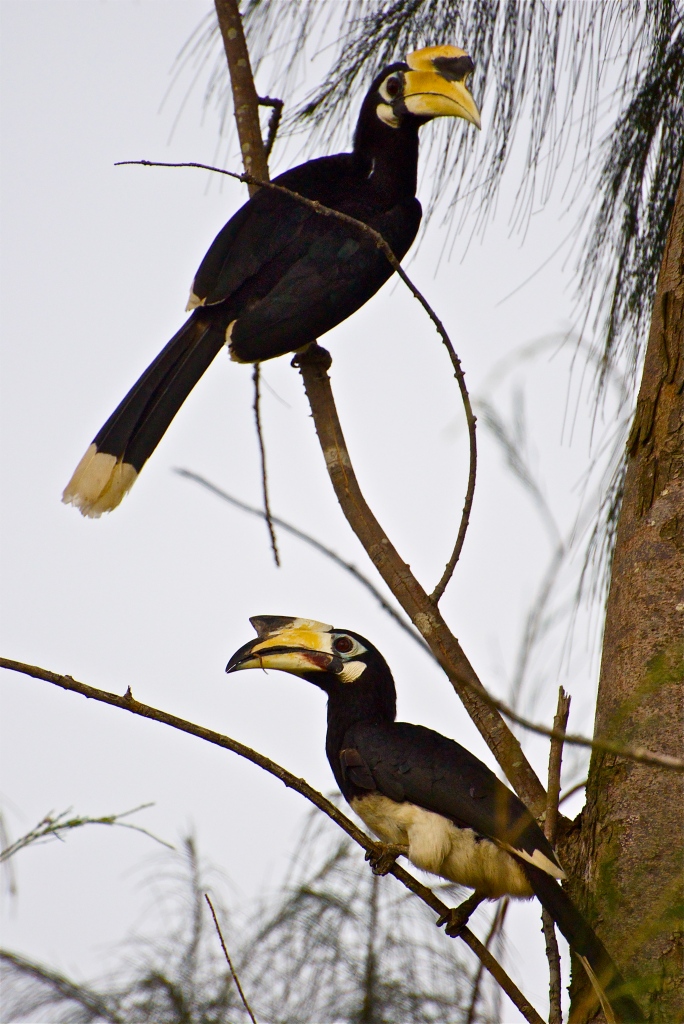
During my time in Asia, I was fortunate to see four other hornbill species and photograph (badly) three of these. The Malabar Pied hornbill in Sri Lanka was easy to find, as it would stand proudly on high dead trees in plain sight.
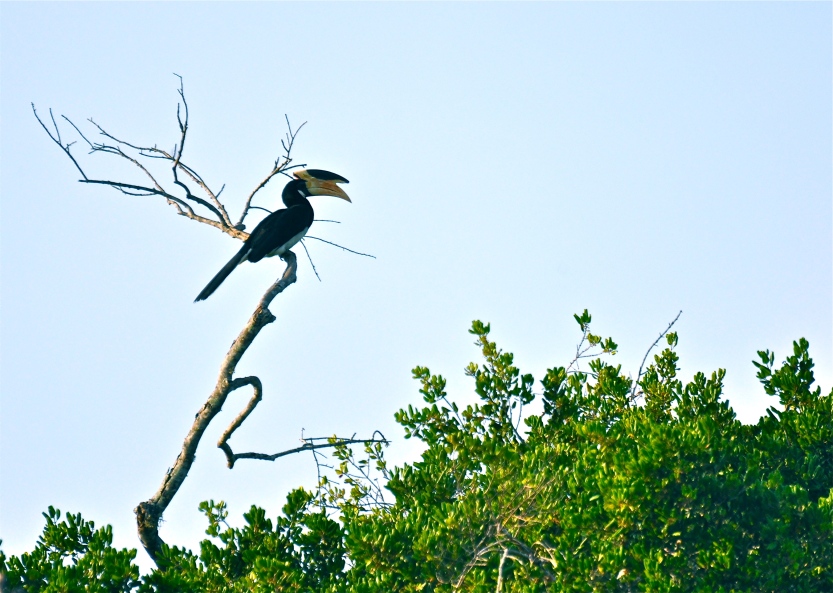
The other species are shyer, preferring the dense canopies and heavy foliage of the tropical rainforests. I saw the Bushy-crested hornbill whilst walking in dense jungle behind a camp site in Sabah, Borneo. I followed a small group of them, trying to get a photograph, until I got lost. It is incredibly easy to become lost in heavy jungle. After some effort, I escaped back to the camp site.
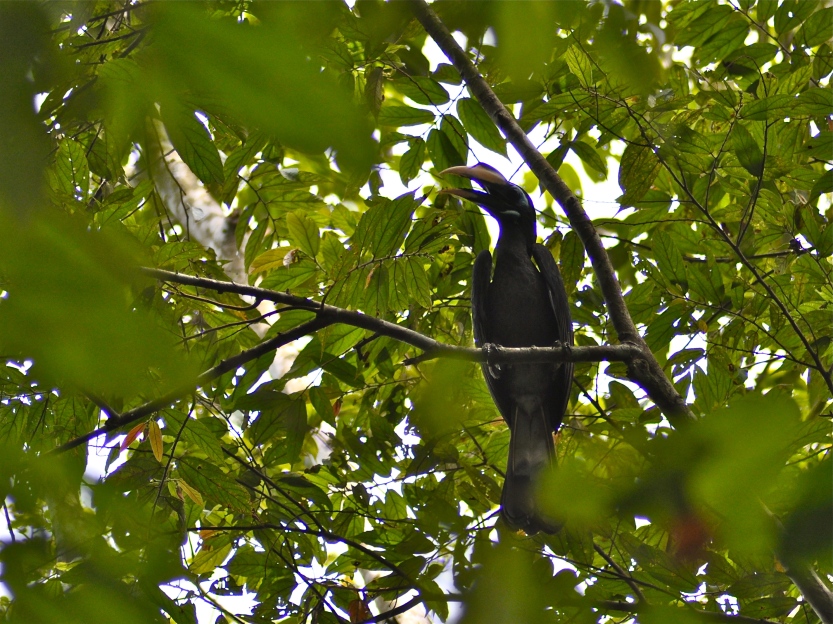
The most spectacular of the Asian species is without doubt the Rhinoceros hornbill. I was enthralled by this huge bird (122 cm or 48 inch), with the extraordinary fire red casque, seeing them 3 times; flying over the canopies in Sabah, Brunei (Borneo) and Sumatra (Indonesia). I did not get close enough to capture a good image of this beautiful bird but I certainly hope to do so one day.
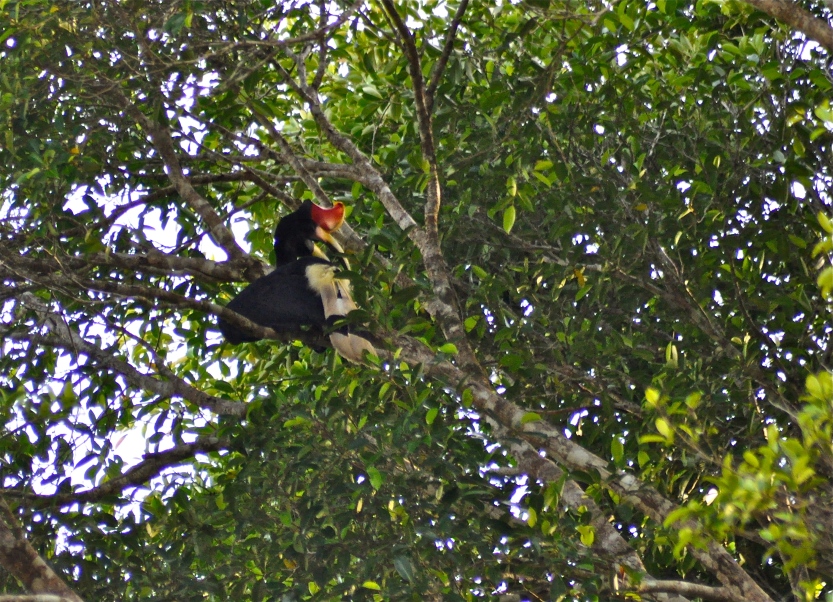
Singapore is quite rightly known as the Garden City, but it is still a major metropolis where nature has to adapt to the green spaces that we provide. It is encouraging that the Oriental Pied hornbill has been able to re-establish a breeding population here.
Many people visit Singapore, often as a stopover destination. Some of these people speak with me of the incredible shopping malls, spectacular food, cutting edge architecture and oppressive humidity. If you find yourself there for a few days, and you love nature, make the time and spend the S$5 return boat fee and look for this bold, comical, fantastic bird of the tropics, while enjoying a side of Singapore that many don’t get to see.
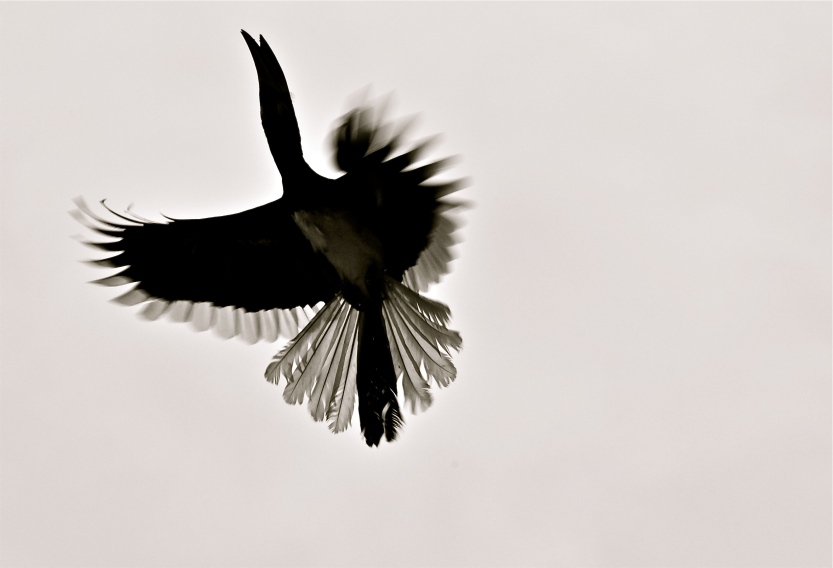
If you enjoyed this post, please follow Incidental Naturalist.
Comments and shares are welcomed.
Categories: Asia
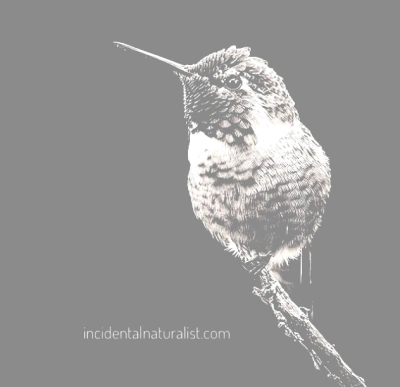




I would say this adventure was indeed a triumph! Great post, David. I enjoyed reading about your different trips to the island, the heat and environs, and the many species of hornbills that you came upon. And it’s really great that the Oriental Pied Hornbill has expanded its territory.
LikeLiked by 1 person
Fascinating story, beautiful birds
LikeLiked by 1 person
I think I’m in love with them too. Great story and photos.
LikeLiked by 1 person
i never heard… how it sound. may be quack quack
LikeLike
Thanks Dear David…
Used to wait for your posts for whats app sharing…. Obviously with your Blogs Name…and credit…
LikeLiked by 1 person
I love this bird (but I love many species…) I saw Oriental Pied Hornbill 2 or 3 seconds in Nepal and I was very happy. I dream to go back in Asia to see Hornbill. Do you advice me Sri Lanka (for Hornbill and more animals)?
LikeLiked by 1 person
I advise Sri Lanka to anyone interested in birds and wildlife. It is fantastic. If you want to see a variety of hornbills then I would advise the Sabah region of Borneo. You can enjoy the special sight of wild ornag-utan while you are there if you are very lucky.
LikeLike
Woooooow orang-utan, it will be fantastic! I’ve ever seen Mountain gorillas in Rwanda and it was amazing… I think I will go to Sri Lana before but I don’t know when.
Have you another bird tri planned?
LikeLike
I saw your gorilla post. Superb! I am not a good planner. Things happen last minute, or locally 🙂
LikeLike
Perseverance well rewarded! The closest I’ve been to these exotic places was Hong Kong, Japan, and Taiwan. How fortunate that you can return to such a magic spot again and again.
LikeLiked by 1 person
These birds are beautiful. I am trying to plan a two week volunteer trip to Thailand to work on a Sanctuary with Gibbons, as non human primates are my wildlife passion (if I had to pick just one). I do think these are fascinating birds and am very grateful you shared the pictures!
LikeLiked by 1 person
Wow that will be an incredible experience! You might see these hornbills while you’re there. You should also look in to the orang utan sanctuaries of Borneo and Sumatra.
LikeLiked by 1 person
I will, thanks! I have a whole list of places I’d like to volunteer and the orange Utan sanctuaries are on there. Unfortunately finance wise I have to start with lower costing ones. I do hope to see the hornbills, they are fascinating. The diversity of the natural world never ceases to amaze me.
LikeLiked by 1 person
A trip worth taking!
LikeLike
Beautiful quality writing and so in formative. love the photos.
LikeLiked by 1 person
Thanks for that kind feedback! Very encouraging.
LikeLiked by 1 person
Excellent post! Growing up, as a reward for good exam grades, my mom would take my sister and I on a day trip to Pulau Ubin every December during our school holidays, where we spent hours drawing pictures of the landscape and wildlife while snacking from our picnic baskets. Back then, my sister even dreamt of being an ornithologist (she’s a veterinarian today). Happy memories you’ve brought back…
LikeLiked by 1 person
Thanks for the wonderful comment! I am very happy that this post brings back the happy memories of childhood for you. It was worth writing for that alone!
LikeLiked by 1 person
I used to live in Singapore and we had a hornbill that visited our garden quite often! I never realised they were so rare in sg!
LikeLiked by 1 person
Wow, how wonderful to see these birds in your garden! Most people get sparrows.
LikeLike
Great post, and some beautiful photos!
Can we ask you and your followers to help us protect birds and their habitats in Europe? The European Union’s looking at changing the very laws which protect a number of at-risk species and created thousands of square kilometres of conservation areas. We’ve got until Friday night to make our case to protect them by putting our names to the public consultation – more details on our Nature Alert campaign here: http://tiny.cc/naturealert
Massive thank you to anyone who reads this and signs!
LikeLiked by 1 person
Thanks to the author, we identified a pair of Oriental Pied Hornills at Gillman Barracks, right in the heart of city today morning. Great experience, watching and identifying them. CG Seshan from Interlace
LikeLiked by 1 person
Thanks for stopping by my blog. It is fantastic to hear that the Hornbills have moved into the city. They are amazing birds, aren’t they? I could watch them all day long. Best wishes!
LikeLike